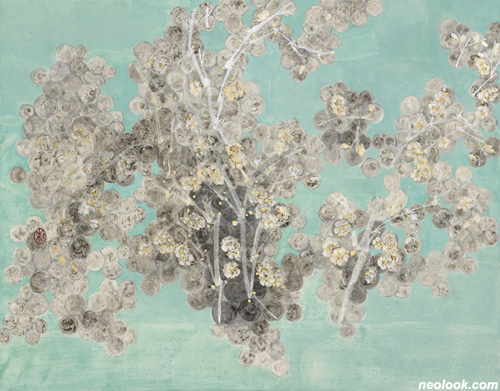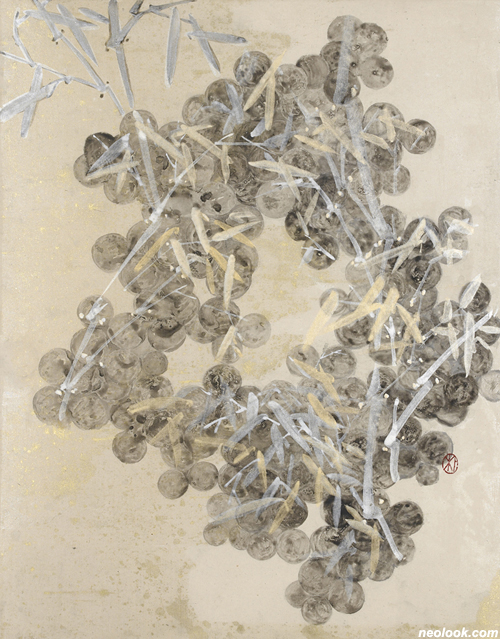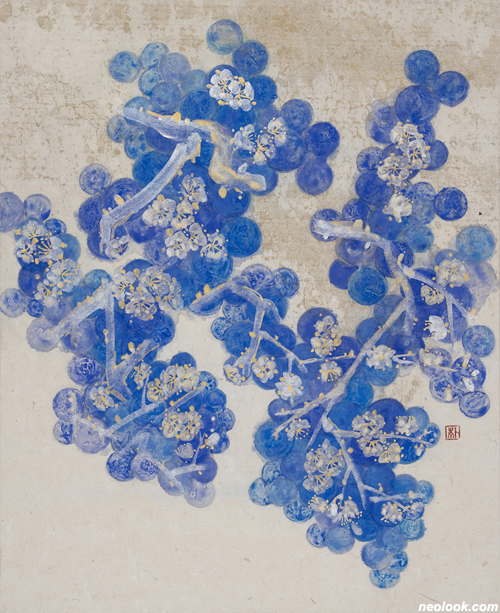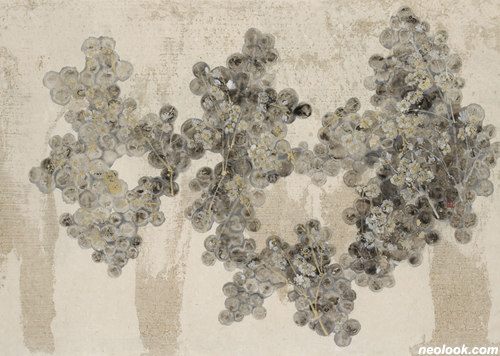- ● homepage
- ● archives
- ● restoration
- ● books
- ● big banners
- ● post board
- ■ neo's search
- ■ about us
- ■ 게재방법 안내
- 개인정보처리방침

- [email protected]
- Tel. 02_335_7922
- Fax. 02_335_7929
- 10:00am~04:30pm
- 월요일~금요일
- 3/3(월) 대체공휴일

The Cosmos and Nature
박소영展 / PARKSOYOUNG / 朴昭映 / painting 2012_0907 ▶ 2012_0916
● 위 이미지를 클릭하면 네오룩 아카이브 Vol.20101126h | 박소영展으로 갑니다.
초대일시 / 2012_0907_금요일_06:00pm
관람시간 / 12:00pm~07:00pm
가회동60 GAHOEDONG60 서울 종로구 가회동 60번지 Tel. +82.2.3673.0585 www.gahoedong60.com
The Cosmos and Nature ● 자연은 동서고금을 관통하여 이어져 오는 미술의 주요한 화재(畵材)로, 많은 화가들은 일정한 함의를 지닌 자연물을 자신의 시각과 심상에 따라 재해석하여 형상화 시켜왔다. 이러한 연장선상에서 박소영은 'The Cosmos and Nature', 즉 '우주와 자연'이라는 보편적 주제를 작품 제목이자 테마로 삼아 작업해 오고 있다. ● 박소영은 우주와 자연을 형상화하기 위해 '원'이라는 기하학적 요소와 한국화의 전통적 소재인 사군자에 주목한다. 작가노트에 따르면 작은 원은 소우주를 상징하고 그 원들이 모여 이루어진 커다란 덩어리는 대자연을 의미하는데, 원이 집적된 형태를 빌어 우주적 형상을 은유적으로 나타낸 것이다. 작가는 원을 '순환과 생성의 의미를 갖는 기하학적 요소'로 인식하고 작품에 등장시켰고, 거기에서 원은 공간을 한정시키기보다는 모든 것을 포괄하고 담을 수 있는 그릇이 된다. 이는 원이 그 형태적 특성에 기인하여 완전함과 영원성을 상징해 온 것과도 연결된다. 그리하여 이러한 원들이 군집한 하나의 커다란 형상은 소우주의 집적체로서 대자연을 품을 수 있는 무한한 공간이 되는 것이다.

- 박소영_The Cosmos and Nature_장지에 수묵, 안료_91×116.7cm_2012
작가는 이렇게 구축한 공간 위에 사군자, 그 중에서도 대나무와 매화를 그려왔다. 여기에서 대나무와 매화는 전통회화의 사군자에 속하므로 일견 박소영의 작품에서도 대나무나 매화가 군자의 표상이나 절조, 효행과 같은 도덕적인 이상을 상징하는 전통적 의미에서 사용된 것으로 생각할 수도 있다. 그러나 작가는 대나무와 매화의 이미지를 군자를 표상하는 의미로서가 아니라 자연을 은유하는 상징으로서 표현한 것이었다. 그에게 대나무나 매화는 자신의 일상 속에서 자연스럽게 접하는 친근한 소재이면서 '자연'의 표상으로서 인식된 소재였다. 박소영이 담아낸 대나무, 매화는 그가 그것들을 본 장소와 시간, 날씨 등을 포함하고 있고 그러한 점에서 작가의 경험과 기억의 집적체이기도 하다. ● 화면에서 작은 원들이 모여서 만들어낸 형태를 보면, 커다랗게 한 덩어리를 이루는 형상이 있는가 하면, 전체적으로는 연결되어 있지만 여러 개의 덩어리들로 이루어진 형상도 있다. 박소영이 우주와 자연이라는 주제로 작업하기 시작한 초기(2008년)의 작품들과 비교해 봤을 때, 당시에는 원들이 집적된 형태가 원과 원이 더 긴밀하게 모인 하나의 덩어리였던데 비하여 이번 작업에서는 복수의 덩어리들로 표현된 경우가 많다. 또 그 덩어리들을 연결하는 사이에 발생한 빈 부분들이 있어 긴장감과 여유가 함께 공존하는 인상을 준다. 작가가 소우주로 상정한 원들이 모여서 대우주가 형성되는 과정에서 공간이 확장됨에 따라 그 구성과 형태에 있어 자연스럽게 변화를 가져온 것으로 보여진다.

- 박소영_The Cosmos and Nature_장지에 안료_97×260cm_2012
원들이 모여 이룬 형상은 한 송이 혹은 여러 송이의 포도로 보이기도 한다. 그러나 이것이 포도로 보이든 다른 형상으로 읽혀지든 간에 그것이 자연을 담아내기 위해서 만들어진 원들의 집적 형태라는 점에는 변화가 없다. 작가에게 원이라는 형태는 작품의 의미를 구성하는 기본 요소이자, 의미를 확장시켜나가는 요소로서 중요성을 가질 뿐이다. ● 한편 이 원들은 무심히 보면 유사한 모습이지만, 화면 가까이 접근해서 들여다보면 하나하나의 원이 각기 농담의 변화를 달리하면서 다른 모습의 독립된 개체, 완전한 소우주로 존재하고 있다. 박소영은 이러한 수묵화의 농담표현과 함께 채색화 기법을 조화롭게 공존시키는 것에 집중한다. 장지(壯紙) 위에 수묵화 기법의 스미고 번지는 효과를 드러낸 원들에서는 농담의 변화에 따른 깊이감과 울림이 있다. 그리고 이 위에 은분과 금분을 아교에 개어 채색하는데, 수묵이 번지고 스며들어가는데 비해 채색은 종이 위에 색이 얹히는 느낌을 준다. 한 번에 원하는 색이 표현되는 것이 아니라 한 층, 한 층 색을 덧입히는 과정을 반복하여 색이 발현되는 것이다. ● 박소영의 '우주와 자연'은 전통회화에 뿌리를 두고 출발한 작가 개인의 경험과 시간의 흔적을 오롯이 담아낸 결과물이다. 제각기 다른 양태의 원들이 만들어낸 우주적 공간과 그 안에 담긴 자연의 성장과 변화, 순환과 반복. 작가가 구축한 질서 속에서 이루어질 다양한 변주는 계속 진행 중이다. ■ 박세연

- 박소영_The Cosmos and Nature_장지에 안료_50×72.7cm_2012
박소영 작가의 작업은 얼핏 보기에 포도송이가 알알이 맺혀있는 것처럼 보인다. 그것이 틀린 표현은 아닐 수도 있다. 그러나 작가의 의도를 조금이라도 더듬어 보자면 포도송이처럼 보이는 원형의 이미지들은 작품 소재인 대나무「竹」와 매화「梅」를 이어주는 기하학적인 공간이다. 마치 현미경으로 들여다 본 미시의 공간에, 매화와 대나무가 다정하게 공존하는 군집된 원형물질의 새로운 세계가 존재하는 듯 하다. ● 동양화 작가라면 누구나 사군자를 쳐 보았을 것이며 죽과 매는 그 단골 소재로서 사용되어 왔다. 그러나 박소영 작가의 작업에서는 신비로움을 간직한 자연물로서 표현되고 있다. 즉 일반적 동양화에 등장하는 사군자가 저마다 간직한 지조, 절개 등의 '미리 정해진 의미' 로서 보여지는 것이 중요했다면, 그의 작업 안에서 죽「竹」과 매「梅」는 서로 조화를 이루며 자연을 품고 있는 원형공간 안에서 변주곡을 만들어 내듯이 각각의 개체가 전체의 일원으로서 하나가 되는 과정인, '순환을 통한 포용'의 결정체 임에 초점이 맞춰져 있는 것이다.

- 박소영_The Cosmos and Nature_장지에 수묵, 안료_116.7×91cm_2012
2009년 개인전 서문에서 미술평론가 김상철은 그의 작업을 '수묵이라는 전통적인 재료가 지니고 있는 정신적 가치의 강조에서 벗어나 물성을 십분 살린 조형 매개로서의 수묵과, 정형화된 상징으로 읽혀지는 사군자가 아닌 자연으로 해석되는 이미지의 번안' 이라고 표현하고 있으며 이를 전통에 대한 재해석이자 재발견의 자세로서 접근하여 풀어나간다. 그리고 현대미술로서의 생명력을 지닌 동양화 장르에서 그의 작업이 단순한 조형적 성취에 그치는 것이 아니라 한국화가로서의 민감한 접점에서 자신의 역할을 다하고 있다고 평가하고 있다. ● 가회동60 에서는 이번 박소영 작가의 전시를 작품 제목의 연장선에서『The Cosmos and Nature』로 정했다. '우주'와 '자연'이라고 하는 위대하고도 원초적인 근원을 예술과 분리시켜 생각할 수는 없다. 그러나 이성적이며 거시적 관점에서 조형성을 표현하고자 하는 순간, 자칫 의도한 그 본질과는 동떨어지는 것을 우리는 흔히 보아 왔다. 감성적이며 미시적인 관점으로 접근할 때 가장 가까운 곳에 출발점이 있을 수도 있다. 태초에 원형물질이 군집한 기하학적 공간 속에 신비로운 형태를 지닌 표상화된 자연물들이 공허한 듯 완벽한 조화를 이루며 존재해 왔음을, 그리고 그것이 우주의 작은 시작임을, 어쩌면 작가는 이미 눈치채고 있었는지도 모르겠다. ■ 김정민

- 박소영_The Cosmos and Nature_장지에 안료_65×53cm_2012
The Cosmos and Nature ● Nature has long been a key subject matter of painting for all ages and countries, so numerous painters have reinterpreted and embodied natural objects with certain implications according to their own viewpoint and image. Against this backdrop, So-young Park has addressed universal themes of 'the Cosmos and Nature' in both title and subject matter of her artistic creation. ● To embody the universe and nature in her artwork, she focuses on geometrical element 'circle' and the Four Gracious Plants (i.e. plum blossom, orchid, chrysanthemum and bamboo), conventional subject matters of traditional Korean painting. According to「Artist's Note」, small circles symbolize a microcosm, and a big cluster of circles indicates Mother Nature. Simply put, such circular accumulation offers a metaphorical embodiment of cosmic shape. So-young Park perceives and captures 'circle' as a geometrical element symbolic of circulation and creation, so circle becomes a vessel to include and embrace everything rather than restricting the space. This is also attributable to the form of circle symbolic of perfection and eternity. These circles are clustered together to form a huge shape as a microcosmic accumulation, thereby becoming an infinite space to embrace Mother Nature. ● So-young Park portrays the Four Gracious Plants, particularly bamboo and plum blossom, in such spatial output. Because bamboo and plum blossom belong to the Four Gracious Plants commonplace in traditional Korean painting, So-young Park's work can be seemingly construed as following the conventional meaning of bamboo or plum blossom emblematic of a virtuous person or moral ideal such as fidelity and filial piety. However, So-young Park expresses the image of bamboo and plum blossom not as an emblem of a virtuous man but as a metaphorical symbol of nature. Bamboo and plum blossom represent not only a familiar stuff that she can naturally encounter in everyday life but also a subject material that she recognizes as an emblem of nature. Bamboo and plum blossom captured by So-young Park includes the place, time, and weather conditions surrounding her observation thereof. In this regard, they are also an accumulation of her experiences and memories. ● The form created by small circles encompasses not only a huge cluster as a whole but also several clusters interconnected together. Compared with So-young Park's earlier works on the theme of the universe and nature (in 2008) where circles are more closely intertwined as a single cluster, this work expresses circles as an embodiment of multiple clusters. Moreover, empty spaces between these clusters gives the impression that tension coexists with relaxation. As circles symbolic of microcosm gather together to create the great universe, space seems to undergo expansion driving natural changes in its composition and shape. ● Such form of circular combination also looks like one bunch or several bunches of grapes. No matter how this appears, namely grape or other shape whatsoever, it is unchangeable that this takes the form of circular accumulation to capture nature. Such circular form matters to So-young Park only as a basic element that constitutes and expands the meaning of her artwork. ● On the face of it, circles look similar overall, but if we take a closer look at the screen, we can find that each circle exists as an independent entity, perfect microcosm in different shapes through variation of shade. So-young Park focuses on harmonious coexistence between such shading method of Indian ink painting and coloration technique. As circles reveal the effect of Indian ink painting techniques by permeating and spreading a thick Korean paper, they generate a sense of depth and resonance driven by variation of shade. So-young Park kneads silver and gold dust with glue for coloration, so color seems to be placed on the paper contrary to what Indian ink permeates and spreads the paper. Instead of expressing their desired color at one time, circles generate color through repetitive addition of color layers one by one. ● With its root in traditional painting, So-young Park's 'The Cosmos and Nature' cherishes her individual experience and trace of time. Cosmic space created by circles in different shapes and natural growth and change plus rotation and repetition therein. Diverse variations still go on under the orderly mechanism established by So-young Park. ■ Se-yeon Park
At a glance, artist Soyoung Park's works appear to be depictions of clusters of grapes. Nor may this necessarily be a wrong description. When one ponders on the artist's intention even slightly, however, the circular images that look like bunches of grapes turn out to be geometrical spaces that link the bamboos and plum blossoms, the subject matters of her works. It is as if there existed, in microscopic spaces seen through a microscope, a new world of clustering circular materials where plum blossoms and bamboos coexisted affectionately. ● Any artist working in the style of traditional East Asian paintings will have drawn the "four gentlemen" (sijunzi; plum blossoms, orchids, chrysanthemums, and bamboos), and bamboos and plum blossoms have been used as favorite subject matters of the style. In Park's works, however, they are portrayed as natural objects with an air of mystery. In other words, if it was important for the "four gentlemen" depicted in traditional East Asian paintings in general to be shown in terms of predetermined meanings such as integrity and fidelity, respectively, in the artist's works, focus is placed on the fact that bamboos and plum blossoms are the crystallization of inclusion through rotation, the process through which individual entities becomes one as elements of a totality as if creating variations on a theme, forming mutual harmony in the circular spaces that embrace nature. ● In the introduction to the artist's solo exhibition held in 2009, art critic Sang-Cheol Kim described her works as "[instances of the] ample use of Chinese ink as a plastic medium, overcoming an emphasis on the spiritual value held by the traditional material of Chinese ink, and adaptations of images interpreted as nature instead of the 'four gentlemen' read as formulaic symbols," approaching and analyzing them as reinterpretations and rediscoveries of tradition. In addition, he evaluated Park as transcending simple plastic accomplishments in the genre of traditional East Asian paintings, which possessed vitality as contemporary art, and fully playing her role as a South Korean artist at a sensitive junction. ● In an extension of the title of one of artist Pak's works, Gahoedong 60 decided on "The Cosmos and Nature" as the title of this exhibition. Indeed, it is impossible to consider art apart from the great and primitive roots of the cosmos and nature. However, we have often witnessed cases where the moment one seeks to express plasticity from a rational and macroscopic viewpoint, the result is remote from the intended essence. When one approaches from an affective and microscopic viewpoint, the starting point may lie in the closest place. ● Perhaps the artist has already been aware—that represented natural objects with mysterious forms have existed in seemingly empty yet perfect harmony in geometrical spaces where circular materials clustered in the beginning and that they were the small beginning of the cosmos. ■ Jungmin, Kim
Vol.20120907k | 박소영展 / PARKSOYOUNG / 朴昭映 / painting

